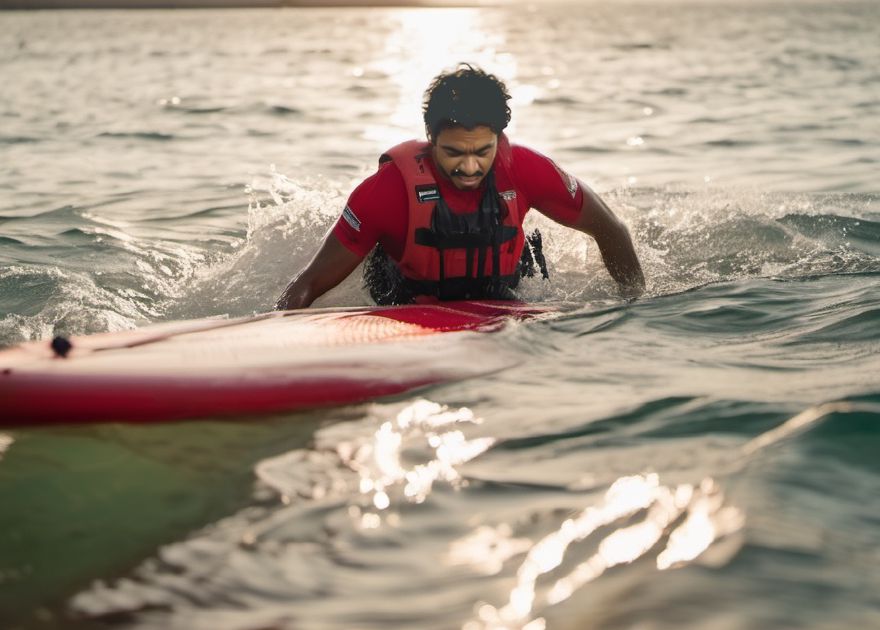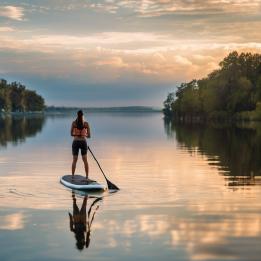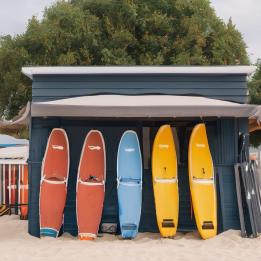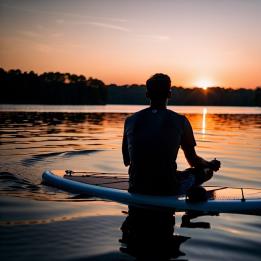Falling Off a SUP? How to Get Back on Your Board

Falling off your paddleboard and into the water is a rite of passage when learning to stand-up paddleboard. But gracefully climbing back aboard can feel daunting, especially for beginners still working on balance and coordination.
Luckily, re-mounting your paddleboard is a skill that improves with practise using proper technique. Our step-by-step guide will walk through exactly how to get back on a paddleboard after taking a spill so you can quickly regain your footing and continue paddling.
Stay Calm After Falling to Avoid Panic
The first step to getting back on your paddleboard after falling is taking a deep breath and remaining calm. Panic causes hurried reactions which often result in a second dunking.
Recovering from a fall is all part of the learning curve - stay cool and you’ll be back cruising in no time!
Assess the situation before leaping into action. Make sure you know which direction your board drifted. Spot your paddle floating nearby and recover it first if possible to have the stability of a two-handed grip.
Waiting an extra few seconds to reorient yourself sets the stage for smoothly climbing back atop your paddleboard.
Use the Leash to Pull Your Paddleboard Back
One of the best investments you can make as a beginner paddleboarder is purchasing an ankle leash. This coiled bungee cord connects your ankle to the tail of the board so that it stays close even after falling off.
Use the leash to your advantage by gently pulling your paddleboard back within reach after tumbling into the water. Don’t yank hard as this can destabilise the board. With soft steady pressure, draw the paddleboard near.
Having your board positioned right by your side is the first step toward getting back on after falling. For more on useful SUP gear, check out our overview of SUP accessories.
Place the Paddle Across the Board for Stability
With your paddleboard now within reach thanks to the leash, place your paddle lengthwise across the centre of the board. This provides an extremely helpful stability platform when climbing back on your paddleboard after falling.
Positioning your paddle horizontally like a balancing bar gives your hands something to brace against as you hoist yourself up from the water. It also helps prevent the board from tilting or shifting as you get situated.
Take advantage of the paddle for extra support and security while re-mounting your paddleboard after taking a spill. When shopping for your own paddle, you might be interested in our adjustable vs fixed paddle comparison.
Assume a Chest-Down Position Over the Paddle
Once you’ve pulled your paddleboard close and laid your paddle across its centre, get into a chest-down ready position along one side. This mimics the typical stance for starting from shore or a dock.
Placing your chest atop the paddle with hands grasping each rail helps lock the board in place. Your torso alone usually won’t dislodge a well-placed paddle.
Getting horizontal and centred gives you the most leverage for lifting yourself up from the water onto the paddleboard in a controlled manner.
Press Down and Lift One Knee at a Time
With hands braced on the paddle and chest resting on the board’s side, you have the stable base needed to start standing up.
Press your chest down while using your core to lift one knee at a time onto the board, positioning each near the paddle. Think “inchworm” style movement while maintaining a tight core.
Once both knees rest securely atop the board, you can release the paddle and use your hands to help press your torso upright into a kneeling position.
Lifting knee by knee avoids rocking the board side to side as you regain proper kneeling stance.
Use Momentum to Stand Up in Stages
The final step is going from kneeling to standing upright using momentum to your advantage. Begin by rocking from your heels onto the balls of your feet into a tall kneeling posture.
Then, use your core muscles to pivot from kneeling to a half-standing crouch, placing one foot forward. Transfer weight to the forward foot, straighten your back leg, and rise using momentum.
Regaining footing after falling requires gradual movements to avoid capsizing again. Build upward momentum without rushing.
Soon, you’ll be standing tall and paddling in no time! With practise, climbing back aboard becomes second nature.
Take a Look at These Life Jackets
Key Takeaways for Getting Back on Your Paddleboard
- Take a breath and assess before reacting
- Use the leash to pull your board close
- Place paddle across board for stability
- Get chest down in ready position
- Lift knees one at a time
- Build momentum gradually when standing
Falling off of your paddleboard is a common occurrence, especially when you’re just starting out. But staying calm and following proper technique for remounting your SUP will have you back on your feet in no time. Be patient with yourself - with a little practise, recovering from falls becomes smooth and effortless.
Let me know if you have any other questions on mastering paddleboard re-mounts!






